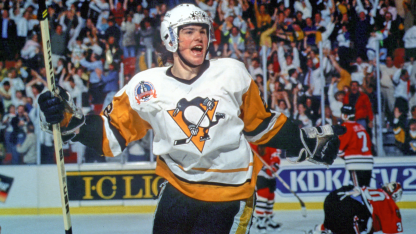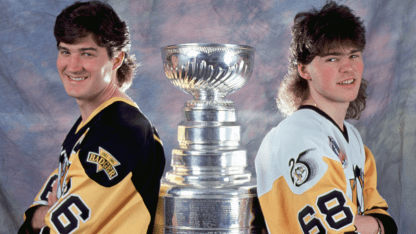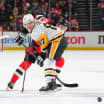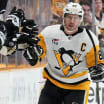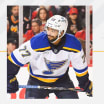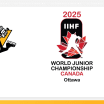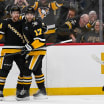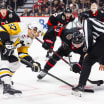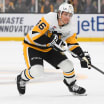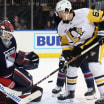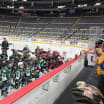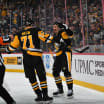On March 31, 1990, the Pittsburgh Penguins fell to the Buffalo Sabres in overtime on a goal from Uwe Krupp in their final game of the regular season.
If the Penguins had just kept the game tied, they would have made the playoffs. Instead, they missed the postseason for the fifth time in six years.
Of course, that stung in the moment … but as Hall of Fame broadcaster Mike Lange said, “I don’t think Penguins fans even realize it today, but that was the best loss ever. It allowed the Penguins to draft at the No. 5 position that summer … and (Pittsburgh general manager) Craig Patrick went out and picked up Jaromir Jagr.
“He was fit, strong as an ox, weighed 240 pounds, and was built to play hockey.”
The Kladno, Czechia native became one of the most accomplished players in NHL history. He ranks fourth all-time in games played (1,733) and goals (766), fifth in assists (1,155), and only Wayne Gretzky (2,857) has recorded more points than Jagr (1,921).
“He was probably the best player in the draft. As we can see, he’s had a very long career, a very successful career. A great Hall of Famer,” Mario Lemieux said.
Jagr was an instrumental piece of Pittsburgh’s back-to-back Stanley Cup championships in 1991 and ’92, his first two seasons in the NHL. Jagr later helped save the franchise from bankruptcy and keep the team in Pittsburgh with his character performance in the first round of the 1999 playoffs while battling through a severe groin injury.
Overall, Jagr spent the first 11 seasons of his 24-year NHL career with the Penguins, winning five scoring titles and one league MVP award during his time in Pittsburgh, where he appeared in 806 regular-season games and picked up 1,079 points.
Jagr is one of the all-time greatest to don black and gold, and now, his No. 68 jersey is finally being raised to the rafters at PPG Paints Arena alongside Lemieux’s No. 66 and Michel Briere’s No. 21.
“I just think, number one, it’s time that we had this type of ceremony,” said Penguins color analyst Phil Bourque, who played a key role in facilitating the ‘Celebrate 68’ festivities. “Especially in the new building here where we’ve had some great moments, but we haven’t had this kind of ceremony in a long, long time in this city, for this team.
“And number two, even though he played for a bunch of other teams, everybody remembers Jaromir Jagr for what he did as a Pittsburgh Penguin.”
When Bourque and some of Jagr’s other former teammates – Ron Francis, Kevin Stevens, Bryan Trottier, and Rick Tocchet – thought back on the impact he had on this franchise, his persona is what first came to mind. They all mentioned Jagr’s long hair styled into that famous mullet, and the huge grin always stretched across his face.
“He's a fun-loving guy, so, everybody kind of bought into that charisma he had. But he didn’t have the talent on the ice, the charisma’s not there,” Stevens said. “You can be a good-looking guy, whatever – but if you don't have any talent, no one really cares, you know? He had that talent. We had a lot of good players in between Mario and Jaromir, but you could see Jaromir was going to be the next charisma-type of a guy like Mario was. Like, just dominate the hockey world in Pittsburgh. You could see Jaromir was going to be the next superstar.”
While Jagr was thrilled to be here, adjusting to his new life in a new country, especially as a young kid, wasn’t easy. “As a first-round pick, it was just kind of feet to the fire,” Bourque said. “He was thrust in and expected to help get this team to the next level. It was some growing pains on and off the ice, I think he’ll admit that. But because he was able to overcome those and come out the other side, I think it made him a better person and a better player.”
A few months later, a teenaged Jagr was lifting the Stanley Cup for the first time – something he would go on to do again the following June. Jagr shined particularly bright during the 1992 Stanley Cup playoffs, recording a playoff career-high 24 points (11G-13A) in 21 games, stepping up when Lemieux went down after the infamous Adam Graves slash in the second round against the New York Rangers.
“Nobody said anything to Jags. He just took it upon himself that Mario’s down, now it's my time. That's the maturity that, as a 20-year-old, you wouldn’t expect,” Bourque said. “He just did it, and we jumped on that bandwagon the way we jumped on Mario’s bandwagon when he would take over games, take over series. Jags did the same thing. It was unexpected, and I can remember clearly being on the bench and going, ‘holy moly, giddy up, let's go, because 68’s going tonight.”
One of Jagr’s most iconic goals came in Game 1 of that year’s Final against Chicago, which tied the game with less than five minutes to go. It stands out to Stevens because, as he put it, the Penguins, in a second straight deep run, were tired and just not playing great. They needed someone to put them on their back, and Jagr did.
“He’s one of the best pressure players I've ever played with,” Tocchet added. “Being able to sit across him going on the ice knowing that when the pressure hits this team, this guy will be there for you, like, this guy will make the right play, this guy will do something incredible under pressure – that’s the best teammate.”

